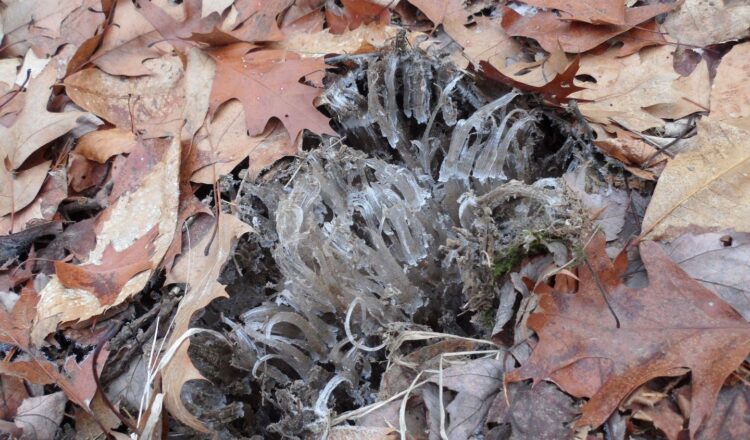by Debbie Bigelow, Master gardener volunteer Cornell Cooperative Extension Allegany County
Our soils have started to cool down and will hopefully soon freeze over. If it hasn’t done so already, it’s time to apply mulch to protect your shrubs and perennial plants from frost heaving. With an adequate snow cover the plants will be somewhat protected, however a burst of spring-like weather can come on suddenly and leave the ground uncovered. Unless you have already placed a protective mulch layer around your plants to keep the soil frozen, they may be jacked out of the ground by frost heaving.
Frost heaving results when liquid water migrates up to the surface from deeper soil layers and freezes into “ice lenses,” so named because their shape resembles a clear lens. Liquid water from below the frozen soil layer is drawn up by capillary action to accrete (grow by accumulation or coalescence) on the lens. Porous or better aggregated soils are more susceptible to the formation of ice lenses than heavy clay soil. Pressure on the soil from the growing ice lens forces the plant up and thawing and refreezing tightens the soil around the plant’s roots and can break them off.

As the freeze-thaw cycle continues, the thawing of the ice lens allows liquid water to drain over the still-frozen soil and erode some of it away, further exposing plant roots. (So, where you’ve taken care to remediate clay soil to encourage your plant growth, you’ve made it more prone to lifting because you’ve increased the porosity that allows water movement.)
The best defense against frost damage is a layer of mulch around the base of your shrubs and perennial plants. Be careful to keep the mulch away from stems, by at least a couple of inches, to discourage rodents from using the mulch to nest and hide where they can nibble on your plants.
When the snow melts, do a preventive check: If you see exposed crown or roots, and the soil is soft enough, you may be able to gently press the exposed roots back down. Have a bucket of soil mixture handy to place on top of any exposed roots. Mulch exposed soil to prepare for the next cycle. Don’t make any judgments on whether a plant may be dead until it’s time for bud break or leaf emergence. If you don’t see either, or if there are no new shoots, you may need to consider replacing the plant.
Online resources for learning about frost heaving and other types of winter injury include this excellent posting from Cornell Cooperative Extension Suffolk County:
https://blogs.cornell.edu/ccesuffolkliga…/tag/frost-heave/
Your CCE Allegany County Master Gardeners are available to help!
Master Gardener Helpline – 585-268-7644 Ext. 23
Leave a detailed message with your contact information. If a Master Gardener is unavailable, they will get back to you as soon as possible. OR send an email to: alleganymg@cornell.edu





